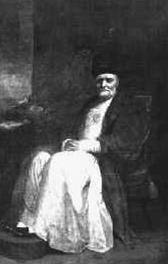- Sir Jamsetjee Jeejebhoy, 1st Baronet
Infobox Celebrity
name = Sir Jamsetjee Jeejebhoy, Bt

imagesize = 150px
caption = Portrait of Sir Jamsetjee at theSir J. J. School of Art
birth_date = birth date|1783|7|15|mf=y
birth_place =Bombay ,India
death_date =death date and age|1859|4|14|1783|7|15|mf=y
death_place =Bombay ,India
occupation = Baron of Bombay, Business Magnate, Philanthropist
salary =
networth =
spouse =
children =
website =
footnotes =Sir Jamsetjee Jeejebhoy, 1st Baronet (variously spelled Qamsetji and Jeejeebhoy, Jejeebjoy, Qijibhai) (
15 July 1783 –14 April 1859 ) was anIndia ncotton andopium merchant andphilanthropist .Early life and business career
Jeejebhoy was born in
Mumbai in 1783, of poor but respectable parents who died shortly afterwards, leaving him an orphan. At the age of sixteen, having had little formal education, he made his first visit toCalcutta and then began his first voyage toChina to trade incotton andopium . [citation|title=The Rise of Business Corporations in India, 1851-1900|last=Rungta|first=Shyam|location=New Delhi|publisher=Cambridge University Press|page=57|id=ISBN 0-521-07354-5.]Jeejebhoy's second voyage to China was made in a ship of the East India Company's fleet. Under the command of Sir
Nathaniel Dance , this ship drove off a French squadron under Rear-AdmiralCharles-Alexandre Léon Durand Linois in theBattle of Pulo Aura .On Jeejebhoy's fourth voyage to China, the
Indiaman in which he sailed was forced to surrender to the French, by whom he was carried as a prisoner to theCape of Good Hope , then a neutral Dutch possession. After much delay and great difficulty, Jeejebhoy made his way to Calcutta in a Danish ship. Undaunted, Jeejebhoy undertook another voyage to China which was more successful than any of his previous journeys.By this time Jeejebhoy had fairly established his reputation as an enterprising merchant possessed of considerable wealth. He settled in Mumbai, where he directed his commercial operations on an extended scale. By 1836, Jeejebhoy's firm was large enough to employ his three sons and other relatives, and he had amassed what at that period of Indian mercantile history was regarded as fabulous wealth.
Jeejebhoy was known by the nickname "Mr. Bottlewaller". "Waller" meant "trader", and Jeejebhoy's business interests included the manufacture and sale of bottles. Jeejebhoy and his family would often sign letters and checks using the name "Bottlewaller", and were known by that name in business and society, but he did not choose this assumed surname when it came to the baronetcy.
Philanthropy
An essentially self-made man, having experienced the miseries of poverty in early life, Jeejebhoy developed great sympathy for his poorer countrymen, and in his later life was occupied with alleviating human distress in all its forms. Parsi and Christian, Hindu and Muslim, were alike the objects of his beneficence. [http://en.wikipedia.org/wiki/New_International_Encyclopedia] Hospitals, schools, homes of charity and pension funds throughout India (particularly in Mumbai,
Navsari ,Surat , andPoona ) were created or endowed by Jeejebhoy, and he financed the construction of many public works such as wells, reservoirs, bridges, and causeways. By the time of his death in 1859, he was estimated to have donated over £230,000 to charity. Some of Jeejebhoy's notable charitable works include:* Mahim Causeway: the British Government had refused to build a causeway to connect the island of
Salsette to Mumbai. Jeejebhoy's wifeAvabai Jamsetjee Jeejeebhoy spent 1,55,800 rupees to finance its construction, naming it after his wife Avabai. The work began in the year 1841 and is believed to have been completed 4 years later.*
Sir J.J Hospital * Jeejebhoy donated to at least 126 notable public charities, including the much acclaimed
Sir J. J. School of Art , [http://www.sirjjarchitecture.org/v2/index.php?option=com_frontpage&Itemid=1 The Sir J.J. College of Architecture] , theSir J.J. Institute of Applied Art and theSeth R.J.J. High School . He also endowed charities dedicated to helping his fellow Parsis and created the "Sir Jamsetjee Jeejebhoy Parsi Benevolent Fund".Baronetcy
Jeejebhoy's services were first recognized by the British Empire in 1842 by the bestowal of a knighthood and in 1858 by the award of a
baronet cy. These were the very first distinctions of their kind conferred by Queen Victoria upon a British subject in India.On Jeejebhoy's death in 1859, his Baronetcy was inherited by his eldest son Cursetjee Jeejebhoy, who, by a special Act of the Viceroy's Council in pursuance of a provision in the letters-patent, took the name of Sir Jamsetjee Jeejebhoy as second baronet.
Jeejebhoy and the Parsi community
From 1838 onward, the Bombay Parsi "
Panchayat " came to be increasingly disregarded as the instrument for regulating the affairs of members of the community that resided in theBombay Presidency . Amidst calls for dissolution of the (then) 110-year old institution for nepotism and fiscal mismanagement (it would eventually be reestablished as administrator of community property), the community gradually came to depend on prominent individuals not connected to the "panchayat" and its improprieties. This was especially true for Jeejebhoy, thanks to his wealth and charitable works and the recognition afforded him by the British authorities due to his baronetcy.References
*1911
External references
* [http://theory.tifr.res.in/bombay/persons/jamsetjee-jeejeebhoy.html Brief profile of Sir J.J.]
* [http://www.zav.org.au/pages/heroes/jamsetjee.htm Brief biography of Sir J.J.]
* [http://music.calarts.edu/~bansuri/pages/sirJJ.html Sir J.J. on David Philpson's site]
* [http://www.the-south-asian.com/April2001/Parsis-Early%20settlers%20in%20Bombay.htm Parsee settlers in Bombay]
Wikimedia Foundation. 2010.
